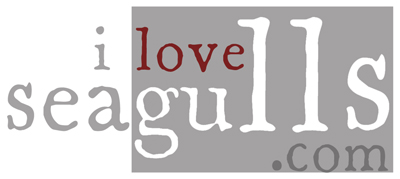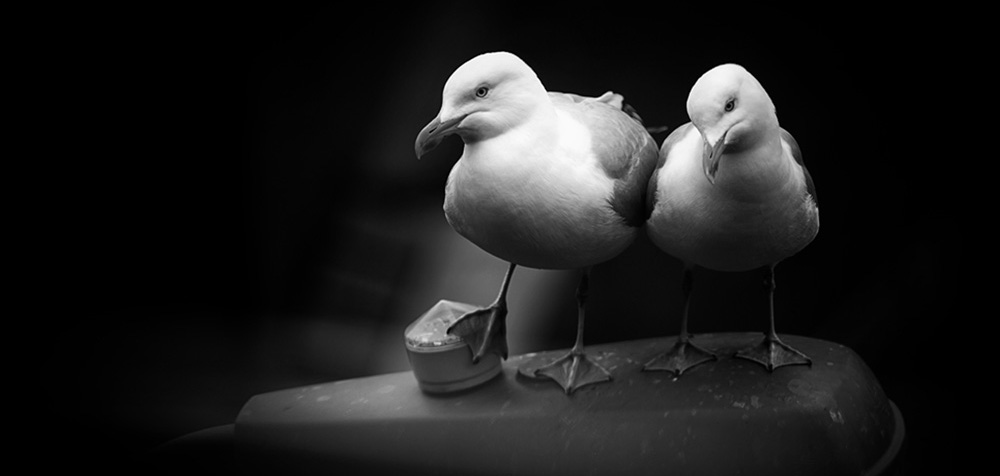‘Seagulls’ are a typical feature of the coastal environment in the UK and a natural part of our country’s wildlife. Gulls have lived close to people for thousands of years but some species are now in decline. So what are `seagulls’, and why are some gulls nesting in urban areas? There is no such bird as a Seagull. It is the collective name that has been given to all Gulls.
What’s that gull?
Seven species of gulls breed regularly in the UK.
Adult Herring Gulls are white, with a pale grey back and wings, black wingtips, and pale pink legs. The Lesser Black-backed Gull is the same size as a Herring Gull, but has a dark grey back and wings, and yellow legs. The Great Black-backed Gull is our largest gull, and has a black back and wings, and pink legs. All three species have a strong, heavy, yellow bill, with a red spot towards the lower tip. The juveniles are difficult to tell apart. They all have mottled grey and brown feathers, and only acquire their adult plumage after four years. These gulls breed around our coast.
Black-headed Gulls are smaller, more delicate birds. They are as common inland as on the coast, frequently seen on playing fields and in parks, especially in winter. They breed in colonies around inland lakes and on coastal marshes. The black-headed gull has a pale grey back and wings, and a dark red bill and legs. In summer, its chocolate-brown head is the most obvious feature, but outside the breeding season this is replaced by a dark smudge behind the eye. The rare Mediterranean Gull is similar in appearance, but has a darker head.
Common Gulls (common only by name!) have a pale grey back and wings, black and white wing tips, and a green-yellow bill and legs. Common gulls breed mainly in Scotland, with isolated colonies in England and Northern Ireland. They are widespread in the UK during winter, both inland and on the coast, and often associate with the similar black-headed gull. Look out for the dark patch behind the eye to tell them apart.
Kittiwakes are the most oceanic of all our gulls. They breed in large colonies, mainly on sea-cliffs, and rarely venture inland or into towns. Their distinctive ‘kitti-wa- ak’ call is characteristic of the wild coasts of the UK. They are the same size as black-headed gulls, grey- winged, with a yellow bill and black legs.
Populations and conservation status
The Kittiwake, with over a third of a million pairs is the most numerous of all the UK gull species. Herring, Lesser Black-backed and Black-headed Gulls each have in excess of 100,000 breeding pairs, while the others have significantly smaller populations.
All seven breeding gull species are birds of conservation concern. The herring gull is now red listed due to the severe declines in its national breeding population, and the other species are amber listed for differing reasons. The rare Mediterranean gull is the only species whose numbers are currently not declining.
Why are gulls declining?
Kittiwake numbers are declining primarily because of shortage of their preferred prey of sandeels. It is thought that this is being driven by climate change. The cause of the declines in other species is not yet known, but could be the result of changes in their maritime environment, including pollution or changes in commercial fishing practices. Research is underway to investigate the causes of these declines so that measures to reverse them can be set out.
Habitat and food
Gulls are found mainly on the coast in summer, although black-headed gulls also nest inland. Large numbers of some gull species move inland in winter, roosting on lakes and reservoirs, and feeding on farm fields and refuse tips.
Kittiwakes feed on small surface-shoaling fish and crustaceans caught offshore, and will also scavenge at fishing vessels. They do not forage inland. Large gulls (herring, lesser black-backed and great black- backed) feed on almost anything of suitable size. Herring gulls generally forage within 10 km of their nests while lesser black-backed gulls will travel much further to feed. They hunt fish and other sea creatures, but also take carrion, rubbish, litter, and waste food, as well as eggs and chicks of other seabirds. They are natural scavengers, and take advantage of organic waste at landfill sites and in towns. All gulls, except kittiwakes, will feed on ploughed fields, and herring and black-headed gulls in particular can be found ‘charming worms’ on pastures, playing fields and other grassy areas.
Breeding
Gulls are semi-colonial nesters, and in some instances form colonies of thousands of birds, especially kittiwakes. Traditional nest sites include sea-cliffs, sand dunes, islands on the coast and inland, and other inaccessible locations. Some lesser black-backed and herring gulls have successfully adopted roofs for nesting. The nest is a well- constructed ‘cup’ made of twigs and grasses. The clutch of two to four eggs is incubated by both sexes for up to 30 days in May and June. The chicks hatch fully covered in down, and are fed by both parents. With the exception of the kittiwake, the chicks leave the nest and move to the relative safety of nearby vegetation when only a few days old. The parents look after them until they fledge after five or six weeks and for a period afterwards. Gulls are long- lived birds – the larger species only start to breed when four years old, and some can live to their upper twenties.
All species of gull are protected under the Wildlife and Countryside Act 1981 and the Wildlife (Northern Ireland) Order 1985. This makes it illegal to intentionally or, in Scotland and Northern Ireland, recklessly injure or kill any gull or damage or destroy an active nest or its contents. In Scotland and Northern Ireland, it is also illegal to prevent birds from accessing their nest, and in Northern Ireland it is illegal to disturb any nesting bird. In addition, the Mediterranean gull is protected under Schedule 1 of both laws, making it illegal to intentionally or recklessly disturb the birds at or close to their nest or to disturb their dependent young.
Natural England Wildlife Management and Licensing Service 0845 601 4523 www.naturalengland.org.uk

